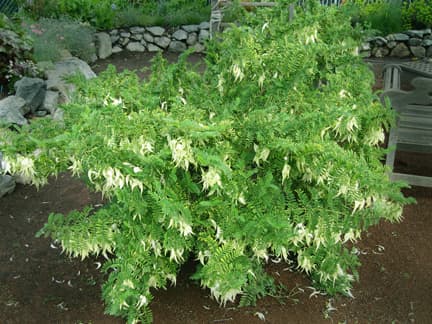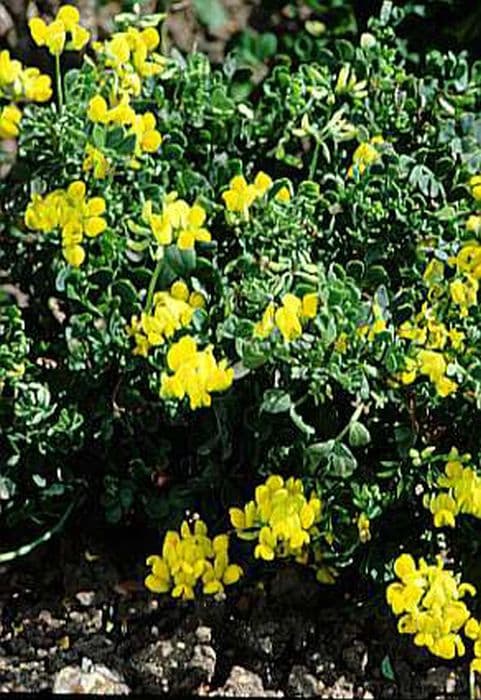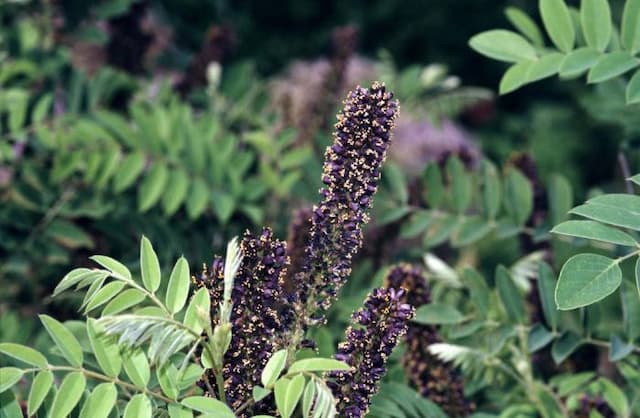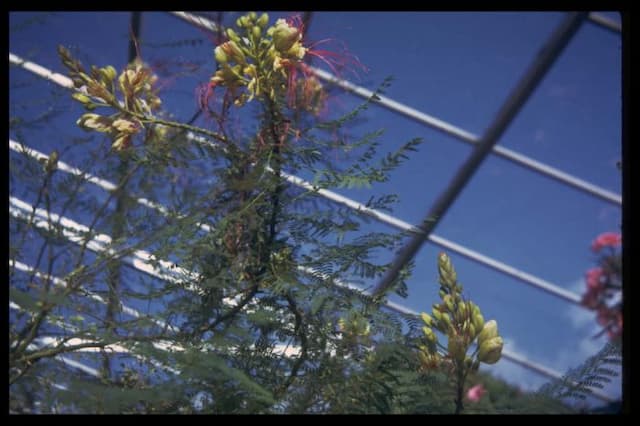Warminster broom Cytisus × praecox

ABOUT
The plant in question, commonly known as Warminster broom, bears a striking and vibrant appearance when in bloom. Its stems are covered with small, trifoliate leaves which create a backdrop of greenery. Each leaf consists of three small leaflets that are somewhat elliptical in shape, offering a textured look to the foliage. Featuring prominently are the brilliant yellow flowers, which emerge en masse, giving the appearance of the plant being wrapped in a sunny cloak. The flowers are typically pea-like in shape, which is characteristic of the family to which Warminster broom belongs. They are profuse and often appear in clusters, adding a dense, colorful display that can be quite eye-catching in its natural setting or in cultivated landscapes. The stems of this particular plant are slender and may arch gracefully, contributing to the overall delicate and airy feel of the plant despite its robust flowering. The bark is usually green to brown, providing a subtle contrast to the foliage and flowers. As a plant appreciated for its blooms and general form, Warminster broom provides a cheerful splash of color in springtime, capturing the attention of onlookers with its profusion of yellow blossoms. The vivid display typically heralds the arrival of the warmer seasons and adds to the variety of colors one might find in a garden setting.
About this plant
 Names
NamesFamily
Fabaceae
Synonyms
Warminster Broom, Allgold Broom
Common names
Cytisus × praecox.
 Toxicity
ToxicityTo humans
The plant known as Warminster broom (Cytisus × praecox) has parts that are considered toxic if ingested. The main toxic components are alkaloids, which can cause symptoms such as nausea, vomiting, and diarrhea if a person consumes parts of this plant. In severe cases, consuming large amounts of Warminster broom could potentially have more serious effects on the human body, including affecting the heart and nervous system.
To pets
Warminster broom (Cytisus × praecox) is also toxic to pets. Similar to its effects on humans, the toxic principles are alkaloids which can lead to gastrointestinal upset in animals, including symptoms like vomiting and diarrhea. In severe cases, especially if a large quantity is ingested, it can potentially cause more serious health issues such as heart problems and neurological symptoms. Pet owners should prevent their animals from ingesting parts of this plant.
 Characteristics
CharacteristicsLife cycle
Perennials
Foliage type
Deciduous
Color of leaves
Green
Flower color
Yellow
Height
4-6 feet (1.2-1.8 meters)
Spread
4-6 feet (1.2-1.8 meters)
Plant type
Shrub
Hardiness zones
5
Native area
Europe
Benefits
 General Benefits
General Benefits- Ornamental Value: Cytisus × praecox, commonly known as Warminster broom or Scotch broom, is highly regarded for its vibrant yellow flowers that can add aesthetic appeal to gardens and landscapes.
- Drought Tolerance: Once established, this plant is quite drought-tolerant, making it suitable for gardens in arid or drought-prone regions.
- Low Maintenance: It requires minimal care once established, making it an attractive option for gardeners seeking plants that do not require frequent attention.
- Erosion Control: Warminster broom can be used on slopes or areas prone to erosion, as its root system can help stabilize the soil.
- Nitrogen Fixation: As a member of the legume family, Cytisus × praecox has the ability to fix nitrogen in the soil, which can improve soil fertility and benefit neighboring plants.
- Attracts Pollinators: The flowers of the Warminster broom attract bees and other pollinating insects, supporting biodiversity.
- Fast Growth: This plant tends to grow quickly, which can be advantageous when trying to establish a garden or landscape feature in a short period of time.
- Adaptability: Warminster broom can adapt to a variety of soil types, although it prefers well-drained soils and full sun exposure.
 Medical Properties
Medical PropertiesThis plant is not used for medical purposes.
 Air-purifying Qualities
Air-purifying QualitiesThis plant is not specifically known for air purifying qualities.
 Other Uses
Other Uses- Cytisus × praecox, commonly known as Warminster broom, can be used in the art of bonsai due to its small leaves and the fact that it can be pruned into miniature tree forms.
- The plant's durable wood is suitable for making small handcrafted items, such as decorative ornaments or inlay work.
- The broom's fibrous stems have traditionally been used for making rough brushes or brooms for cleaning.
- Warminster broom can serve as a natural dye; its flowers yield a yellow dye, while the bark can provide different shades of green.
- The aromatic qualities of Warminster broom make it suitable for adding a pleasant fragrance to potpourris or herbal sachets.
- The dense branching pattern of the broom is utilized in creating shelterbelts or windbreaks in rural areas.
- Its rapid growth and attractive blossoms are ideal for reclaiming and stabilizing soil in areas at risk of erosion.
- Insect-friendly gardens benefit from Warminster broom as it attracts a variety of pollinators like bees and butterflies.
- Due to its tolerance for poor soils, Warminster broom is used in landscaping to rehabilitate disturbed land, such as former mines or construction sites.
- The vibrant yellow blooms of Warminster broom are used in floral arrangements, specifically for spring-themed decorations.
Interesting Facts
 Feng Shui
Feng ShuiThe plant Warminster broom is not used in Feng Shui practice.
 Zodiac Sign Compitability
Zodiac Sign CompitabilityThe plant Warminster broom is not used in astrology practice.
 Plant Symbolism
Plant Symbolism- Renewal: Cytisus × praecox, commonly known as Warminster Broom, blooms in the spring, symbolizing the renewal and rebirth that comes with the season.
- Humility: The broom's modest flowers are often seen as a symbol of humility in the plant world.
- Purification: Historically, brooms like the Warminster Broom were used for sweeping and cleaning, leading to their association with purification.
- Protection: Folk traditions sometimes hold that broom plants can ward off evil, so the Warminster Broom may carry connotations of spiritual protection.
 Water
WaterFor the Warminster broom (Cytisus × praecox), it's crucial to maintain moist soil during its first growing season. Water the plant deeply once a week, providing about 1 to 1.5 gallons of water each time depending on rainfall and soil type. Once established, the plant is relatively drought-tolerant, so you can reduce watering to every two weeks, especially in cooler climates. Be cautious to avoid overwatering, ensuring the soil has good drainage. During the growing season, if there's a prolonged dry spell, you may need to return to weekly watering to keep the plant healthy.
 Light
LightThe Warminster broom thrives best in full sunlight, where it can receive at least 6 to 8 hours of direct sunlight daily. Choose a spot in your garden that is free from the shade of buildings, trees, or other structures to ensure it gets ample light. However, it can tolerate partial shade, but its blooming may be less vigorous.
 Temperature
TemperatureWarminster broom prefers temperate conditions and can tolerate a range of temperatures. For optimal growth, maintain temperatures between 65 and 75 degrees Fahrenheit. It can survive minimum temperatures down to 20 degrees Fahrenheit, but frost and prolonged cold temperatures below this can damage the plant.
 Pruning
PruningPrune the Warminster broom immediately after it finishes blooming to maintain its shape and encourage new growth for the following season. This plant benefits from pruning to remove dead or weak stems and to prevent it from becoming leggy. Annually, after the spring bloom, cut back about one-third of the older stems to ground level.
 Cleaning
CleaningAs needed
 Soil
SoilWarminster broom (Cytisus × praecox) thrives best in well-draining soil with a pH of 6.0 to 7.5. A mix of loam, sand, and peat is ideal to provide the right balance of drainage and moisture retention. Regular garden soil amended with horticultural grit or coarse sand can also be effective to ensure good drainage.
 Repotting
RepottingWarminster broom typically does not require frequent repotting and can thrive in the same pot for several years. This hardy shrub may only need repotting if it becomes root-bound or the soil has degraded significantly, which might be every 3-5 years.
 Humidity & Misting
Humidity & MistingWarminster broom is adaptable to a range of humidity levels and does not have specific humidity requirements. It's a relatively hardy plant that can tolerate the variable humidity levels typically found in outdoor garden environments.
 Suitable locations
Suitable locationsIndoor
Place Warminster broom near a sunny window; water moderately.
Outdoor
Plant Warminster broom in full sun; well-draining soil.
Hardiness zone
5-8 USDA
 Life cycle
Life cycleCytisus × praecox, commonly known as Warminster broom, begins its life cycle as a seed, which germinates in favorable conditions of warmth and moisture, often in early spring. Upon germination, it develops a root system and a shoot that grows into a young sapling, displaying compound leaves typical to brooms. As the plant matures, it enters a vegetative state where it grows rapidly, forming a woody stem and branching habit, preparing for reproduction. In the spring of its maturity, generally in the second or third year, Warminster broom produces vibrant yellow flowers, rich in nectar, attracting pollinators that facilitate cross-pollination. After successful pollination, the flowers develop into small pods containing seeds, which, when mature, burst open to disperse seeds, propagating the next generation of plants. The plant is relatively short-lived, with many specimens living only 5 to 10 years, after which they complete their life cycle and die, though they may leave behind numerous seeds to continue the species.
 Propogation
PropogationPropogation time
Spring
The most popular method of propagation for Warminster Broom, the common name for Cytisus × praecox, is stem cuttings. This process typically takes place in the late summer. Semi-hardwood cuttings, which are stems that are partially matured and slightly firm, are collected from new growth. The cuttings should be about 6 inches (approximately 15 centimeters) long with the lower leaves removed. The base of the cutting is then dipped into a rooting hormone to encourage root growth and planted in a well-draining soil mix. The soil should be kept moist until roots have established, which normally takes several weeks. Once rooted, the young plants are hardened off before being moved to their final position in the landscape.








